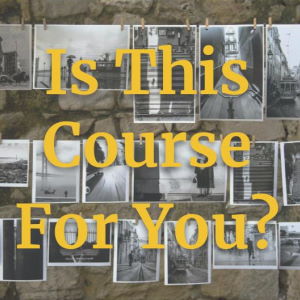What Is A Teacher Bio
The perfect curriculum with a solid teacher summary can help sell more courses. Teacher bios create trust and confidence to move forward with the purchase of a course.
Surprisingly, it is very easy to create the essential parts of a good teacher profile. Most importantly, we want to stop you from including any dealbreakers that make prospects immediately skip over you.
Top Mistakes
Here are the most common online teacher “About Us” problems:
- Vague one-line bio
- Using a logo icon instead of your real face
- Having typos in your description
- Not having any reviews
- Not highlighting years of experience
Your Profile Picture
Having a nice picture of you will help the course look good. It doesn’t have to be a professional studio photo, but it should be high quality and show you looking at the camera.
The photo thumbnail may be small, so having a closeup that scales down well is also important. In some cases, the profile picture may be in an oval shape, so make sure you use a headshot that is centered.
Is your background appropriate or out of context? Think about the location of the image. Is your background busy, where it is hard to see your face? Avoid having other people or cropped parts of people.
Your Teaching Name
Use your proper name like “Margaret Tutti Perez” or your shortened name “Peggy Perez” for your teaching bio.
Do not use an online handle like “PrettyThreads” or a strange email address like “Girl571PrinceSt”.
If you are afraid of putting too much information on the internet, you can use a shortened name like “Peggy P.” or “Ms. Perez”
Your Short Title
A smart short title can help customers orient around your bio. It can send the message that this is a person I want to learn from. Something random like “Sewing and Sneaker Rebel” may be a head-scratcher and work in some cases, but something like “20y Seamstress Expert” is another positive thing why they should buy your course.
Your Main Bio
Your main bio should talk about your skills, education, experience, and provide insight into your personality.
Specify your exact skills, and don’t be afraid to get specific. For example, you may teach design, and it may be nice to add that you are an expert at designing new fonts.
If you have degrees, or certificates, that can help give confidence to buyers, then you should list them. However, if your degree was in Statistics, then you may not want to mention that degree if you ended up a Culinary Chef.
Mention top industries or well-known companies that you have worked at or helped over the years. If you have a tricky resume work your relevant companies into your story arc.
Choice of Words
Think about your choice of words in all the parts of your about me page. Your words paint an image about you like are you down to earth, fancy, global, experienced, young, hip, etc.
Even the words you use to greet, provide prompts, and sign off are important parts of your brand voice. Your brand voice should be consistent with your course sales page, curriculum description, and course materials.
Your Reviews
If your course platform highlights customer reviews, try to have a few reviews so that prospects can see that other students have had success with your classes.
If necessary, you can use a free link or coupon to have some friends or family review your course. They can quickly do you a favor by logging in, watching a few lessons, and leaving a friendly review about the content. Afterward, you can follow up to get private feedback from them so that you can improve your sales page, descriptions, and course.
Your Total Courses
If you have several courses, advertising the number will instill confidence in buyers. Similar to book authors, it is good to know when teachers are experienced and deeply knowledgeable in an area that you’re interested in. Seeing a teacher of three courses creates an image that they know a lot about a topic and they know what they are doing.
Your Social Media
If you have a nice collection of images, tips, and videos on your social profiles, link up your teacher profile with those business or personal accounts.
This allows students to view your work, your followers, and communication style.
If customers are not ready to buy your course yet, they may follow you and ultimately buy at a future time when they have more confidence in you.
However, don’t include your social accounts if they are truly personal with jokes, family, and friends from college. Make a note or task yourself to create a business account when you can.
Additionally, don’t feel the need to include every social account. If you have appropriate content then use them. It is best to link to external accounts that will help not reduce your sales.
Your Course Hero shot
You should have a course hero shot that is your #1 picture of your course.
It may be a beautiful graphic design of your course, almost like a book cover with your course title.
A hero shot could be a close-up of what you are teaching, so as an example, it could be a closeup of a blouse you are showing how to make with a nice title like “How to make women’s tops”.
Your Course Preview Picture
When creating a course sales page or teacher profile, including a video of yourself can make a significant impact. If you have a teacher introduction or course preview video, it’s crucial to select an optimal thumbnail image.
While the first frame might automatically serve as the preview, take the time to choose a frame that best represents your teaching style. Avoid mid-action shots where you might be blinking, blurry, or caught in an awkward expression. Instead, opt for a thumbnail that captures you in a strong, confident teaching pose—perhaps demonstrating a technique on your sewing machine or guiding viewers through an Adobe program.
Remember, some viewers may not immediately recognize that the image is a video, so ensure the preview showcases you at your best, effectively communicating your expertise and enthusiasm for the subject. This image is often the first impression potential students will have of you, so make it count!
Teacher’s Location
Some course systems show where the teacher is from. So, if you are from a highly desired location like New York, Los Angeles, Paris, Toronto, or Sydney, you may want to highlight where you are from. Additionally, some specific skills are associated with locations like culinary design in Italy, or artisan crafts in a South American small town. Shoppers may associate some value when comparing you to other teachers because of your experience from being at your unique location.
Conclusion – Teacher Bios Help Sell Courses
Teacher bios can have a large impact on helping a prospect get comfortable with your course. Questionable teacher info can add doubt and keep the customer uncommitted in the shopping stage, however, a positive teacher “About Us” section can help you seal the deal right when they are most likely to buy.
You should be a little more smarter now. Thanks for hanging out!
Please subscribe to get more tips for creative online course teachers.
FAQ How To Make A Teacher Bio That Sells
These lessons can also help you with Education and Course Content:
- Teaching Creative Online Courses Using Drip Feeding
- Microlearning – Teaching One Small Thing Per Lesson
- Teaching Content Using A Picture-In-Picture Layout
- Hybrid Teaching












